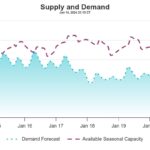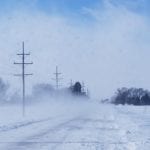Texas Gov. Greg Abbott has said reforming the Electric Reliability Council of Texas (ERCOT) is an emergency item for state legislators in the current session, as power outages continue across the state for another day due to record cold temperatures as part of a massive winter storm.
The governor on Feb. 16 said he wants lawmakers to investigate ERCOT, which operates much of the state’s electric grid and manages its deregulated power market, even as he said it would have been impossible to prepare “for this type of event, because the last time we had this type of weather was more than 100 years ago.” The severe weather’s impact on electricity supply caused the U.S. Dept. of Energy to issue a situation report Tuesday.
More than 4 million Texas electric customers were without power Tuesday morning, and as many as 3 million remained without power late Tuesday, with no timetable as to when electricity service would be restored. Many people in Texas have been without power for two days or more. Bill Magness, ERCOT’s CEO, asked Tuesday when the outages would end, could not give a firm answer.
“The number one job of everybody here at ERCOT is to get people’s lights back on,” Magness told Fort Worth radio station WFAA. “We’re seeing demand in the winter nearly like we see at the top of the summer, when we’re all using our air conditioners.”
He continued: “We have seen nothing like this honestly in Texas, that has covered the state like the storm has. It increased demand to an extreme, extraordinary height, and then the storm also made it difficult for the supply to be provided. I think we can see those customers getting more and more service during the course of this week, but it just depends on, you know, how the weather turns and how much of the power supply we can make sure is secure.”
(Editor’s note: Read this paper from executives with Grid Strategies LLC, who provide their observations about the Texas blackout situation.)
Ice, Cold, and Snow
Ice, cold, and snow has blanketed much of the U.S. from the Rocky Mountains to the East Coast this week. In Texas, Dallas’ morning low Tuesday of minus 2 degrees was the city’s coldest since 1949. Many parts of the state, including Houston, saw single-digit temperatures.
The impact has reached beyond Texas: electricity use exceeded generation Monday in three of the seven organized electricity markets in the U.S.: ERCOT, the Southwest Power Pool (SPP), and the Midcontinent Independent System Operator (MISO).
Gov. Abbott on Tuesday said, “The Electric Reliability Council of Texas has been anything but reliable over the past 48 hours. Far too many Texans are without power and heat for their homes as our state faces freezing temperatures and severe winter weather. This is unacceptable. Reviewing the preparations and decisions by ERCOT is an emergency item so we can get a full picture of what caused this problem and find long-term solutions. I thank my partners in the House and Senate for acting quickly on this challenge, and I will work with them to enhance Texas’ electric grid and ensure that our state never experiences power outages like this again.”
150 Million Impacted
The National Weather Service on Monday said more than 150 million Americans were under some type of winter storm watch or warning, with frigid temperatures, and heavy snow and ice, continuing to hit parts of the the country from the Southern Plains to the Ohio Valley, and into the Northeast. Some of those weather alerts were canceled Tuesday, but the threat of continued cold temperatures remained for much of the nation.
Along with the power outages in Texas, thousands of people in Louisiana, Mississippi, and elsewhere also had suffered blackouts, in many cases due to ice bringing down power lines. Power outages stretched from Oregon in the western U.S., to Virginia along the East Coast.
Devin Hartman, former president of Electricity Consumers Resource Council and an analyst for the Federal Energy Regulation Commission, in comments to POWER said ERCOT needs to take a look at its demand response actions in the wake of the current crisis.
“Enabling demand response and permitting high prices—provided they reflect market fundamentals—are very important,” Hartman said. “The ERCOT and the Public Utility Commission of Texas appealed for voluntary consumption reductions, known as demand response [DR]. This helps during a crisis, but the policy imperative moving forward is to achieve a system where far more low-value electric uses get curtailed—thus protecting reliability for high-value uses—consistent with consumers’ preferences.
“Over the last two years, ERCOT has seen roughly two gigawatts of DR during peak periods in response to price spikes, which has impressed many in the industry. But this week’s event highlights the need to get into far deeper tiers of DR. To keep transactions cost down, DR activity is most efficiently coordinated through preset arrangements where customers express their willingness to pay for continuous service and, when prices exceed these levels, their service is automatically curtailed. Legislators and regulators must resist the temptation to suppress price spikes, which are critical signals to put scarce resources to their best use, and instead focus on how to ensure price movements reflect underlying supply-demand fundamentals and not market manipulation.”
Record Power Demand
President Joe Biden approved a state of emergency declaration for Texas on Sunday after a request from Abbott. The problems there stem from a record spike in electricity demand for heating due to the cold temperatures, which also created problems for the state’s energy supply. The emergency situation began in the early morning hours Monday when several Texas power plants tripped offline in rapid succession.
ERCOT said it lost about 34 GW of power supply as the cold temperatures forced both coal-fired and natural gas-fired plants offline. The cold also reduced the supply of natural gas to power plants, and caused wind turbines to freeze. Wind supplies the second-most amount of power to Texas customers, behind natural gas, and the turbines in Texas are not equipped with cold weather packages that would enable them to operate in extreme cold.
Patrick Milligan, a manager of energy power markets with ICF, a global consulting and technology services company, in an analysis shared with POWER on Tuesday said natural gas production in Texas as of Monday had fallen at least 16% due to well freeze-offs and shutdowns of gas processing plants.
Milligan noted that “the magnitude of the [blackout] event could prompt structural changes in the power market: ERCOT does not have any mechanism to enforce a minimum planning reserve margin as do most other major power markets. Partially as a result, ERCOT has had extremely low reserve margins for the past several years. Among skeptics of ERCOT’s approach, a common quip was ‘ERCOT is one blackout away from a capacity market.’ Such a blackout may have arrived.”
Rolling Blackouts
Grid operators on Monday began rolling blackouts in Texas, shutting off power to different areas for periods of time, and utilities asked customers to reduce their electricity use. But some blackouts have continued, prompting the governor’s emergency declaration Tuesday.
MISO on Monday declared a Maximum Generation Event—Emergency Event Step 2c in its South Region, which includes southeast Texas along with parts of Arkansas, Louisiana, and Mississippi, due to the extreme cold and weather conditions causing high demand on the bulk electric system. The grid operator made a public appeal to customers to conserve electricity.
“The frigid temperatures have increased the number of uncertainties and conditions are changing to a point where demand could exceed supply,” said Renuka Chatterjee, executive director—System Operations at MISO, in a news release late Monday. “We’re moving into uncertain territory which is why we are asking the public for assistance.”
—Darrell Proctor is associate editor for POWER (@POWERmagazine).










